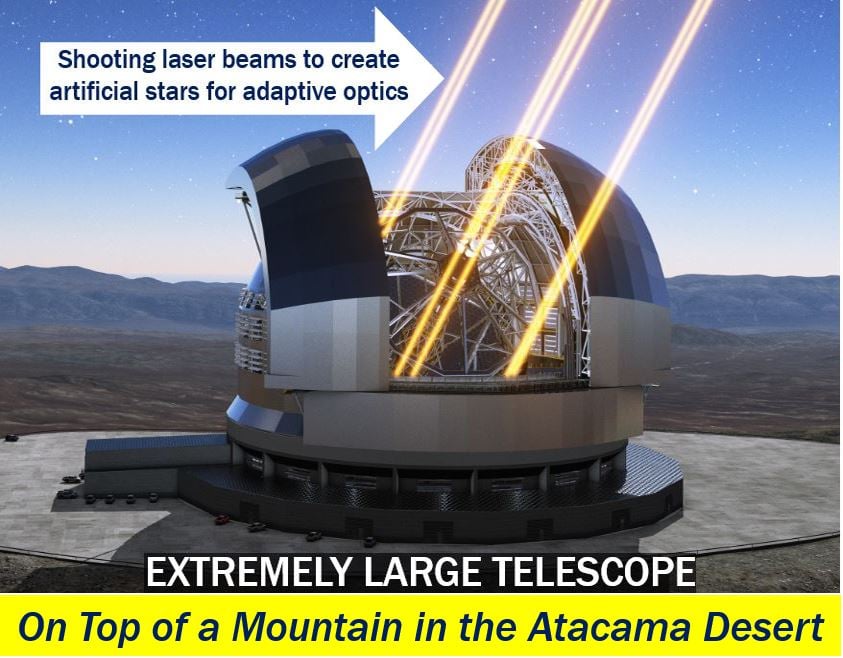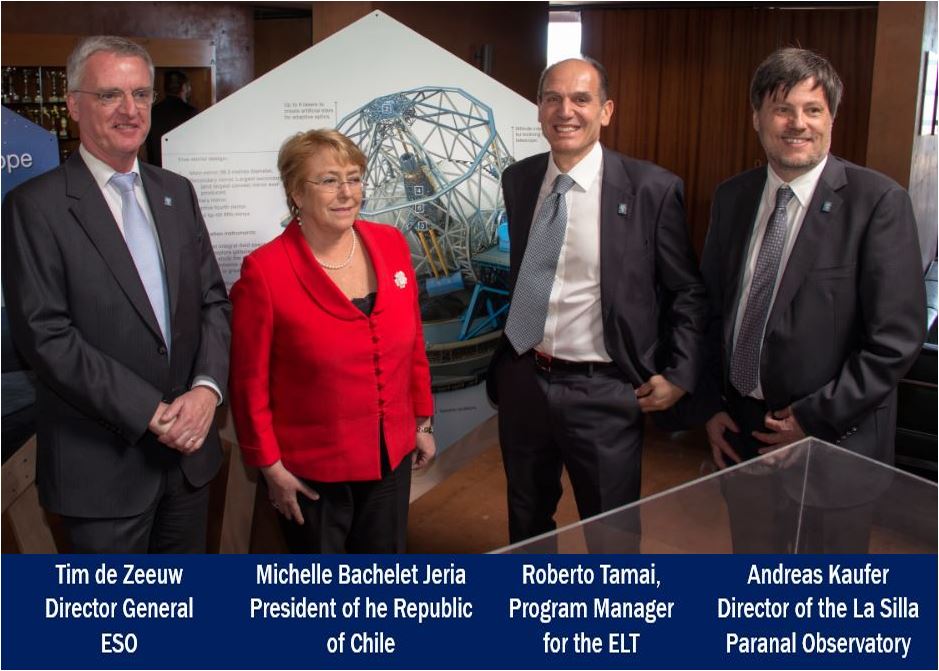A super telescope is being built in northern Chile on top of a mountain in the Atacama desert. The super telescope – called the Extremely Large Telescope (ELT) – will be the largest optical telescope in the world; five times bigger and more powerful than what is available today, say scientists from the European Southern Observatory (ESO).
In a ceremony last Friday, Chile’s President, Michelle Bachelet Jeria, Director General of the ESO, Tim De Zeeuw, and other astronomers, physicists, and lawmakers were at the ceremony to mark the placing of the first stone of the super telescope construction project.
According to astronomers, when the giant optical/infrared telescope is complete, it will completely change our current understanding of the Universe.
The super telescope will be mounted on a massive dome 85 meters in diameter, which as about the same as the area covered by a football (American English: soccer) pitch.
 An artist’s illustration of the super telescope – the Extremely Large Telescope – on the Cerro Amazones in the Atacama desert in northern Chile. Chile’s President, Michelle Bachelet Jeria, attended the first stone ceremony on Friday, 26th May, 2017. (Image: eso.org)
An artist’s illustration of the super telescope – the Extremely Large Telescope – on the Cerro Amazones in the Atacama desert in northern Chile. Chile’s President, Michelle Bachelet Jeria, attended the first stone ceremony on Friday, 26th May, 2017. (Image: eso.org)
Super telescope operational in 2024
If the construction project goes according to plan, the ELT should be operational in 2024.
Scientists, astronomers, and amateur astronomers across the world hope that this super telescope will speed up our search for alien life somewhere in the Universe.
During the ceremony, a time capsule was sealed. Inside the capsule there is a copy of the book that describes ELT’s future scientific goals, as well as a poster containing photographs of all current ESO staff.
Regarding the construction of the new super telescope, President Bachelet said:
“With the symbolic start of this construction work, we are building more than a telescope here: it is one of the greatest expressions of scientific and technological capabilities and of the extraordinary potential of international cooperation.”
 The first stone ceremony, which was attended by Chile’s President, was held at ESO’s Paranal Observatory, very near to the future home of the new super telescope. (Image: eso.org)
The first stone ceremony, which was attended by Chile’s President, was held at ESO’s Paranal Observatory, very near to the future home of the new super telescope. (Image: eso.org)
Consortium building the super telescope
ESO signed a contract with Ace Consortium last year. Ace Consortium comprises Astaldi, Cimolai, and the EIE Group, a subcontractor, for the construction of the structure (eso1617) and the dome.
Regarding humans’ quest for signs of life in the Universe, ESO wrote:
“The ELT will be the biggest “eye” ever pointed towards the sky and may revolutionise our perception of the Universe. It will tackle a wide range of scientific challenges, including probing Earth-like exoplanets for signs of life, studying the nature of dark energy and dark matter, and observing the Universe’s early stages to explore our origins.”
“It will also raise new questions we cannot conceive of today, as well as improving life here on Earth through new technology and engineering breakthroughs.”
About the Extremely Large Telescope
ESO says that this super telescope is considered across the world as one of the top priorities in ground-based astronomy. Extremely Large Telescopes will considerably advance our astrophysical knowledge.
The ELT that is now under construction in northern Chile, in the world’s driest desert, will allow detailed studies of the first celestial objects in our Universe, super-massive black holes, planets outside our solar system, and the nature and distribution of two phenomena that dominate the Universe – dark energy and dark matter.
“The ELT will tackle the biggest scientific challenges of our time, and aim for a number of notable firsts, including tracking down Earth-like planets around other stars in the ‘habitable zones’ where life could exist — one of the Holy Grails of modern observational astronomy.”
“It will also perform “stellar archaeology” in nearby galaxies, as well as make fundamental contributions to cosmology by measuring the properties of the first stars and galaxies and probing the nature of dark matter and dark energy.”
“On top of this astronomers are also planning for the unexpected — new and unforeseeable questions will surely arise from the new discoveries made with the ELT.”
 An artist’s impression comparing the super telescope with the Arc de Triomphe in Paris, France. (Image: eso.org)
An artist’s impression comparing the super telescope with the Arc de Triomphe in Paris, France. (Image: eso.org)
Is there life out there?
Scientists hope that this super telescope will help answer a question that fascinates virtually every human on Earth: “Are we alone in the Universe?”
The Extremely Large Telescope will search not only for Earth-like planets by indirectly measuring the wobbling motion of parent stars, but also by directly imaging larger planets, and maybe even the features and makeup of their atmospheres.
ELTs suite of state-of-the-art instruments will allow researchers to probe the first stages of the formation of planetary systems, and to detect water and organic molecules in the protoplanetary disks around stars as they form.
In an article titled – ‘Are we Alone?’ – ESO says:
“Thus, the ELT will answer fundamental questions regarding planet formation and evolution and will bring us one step closer to answering the question: are we alone? Apart from the obvious scientific interest, this would represent a major breakthrough for humanity.”
Video – Flying into the ELT
This ESO video flies us from the outside of the super telescope into the interior of the dome. You can see the complex and massive telescope structure and the 39-meter segmented main mirror.

